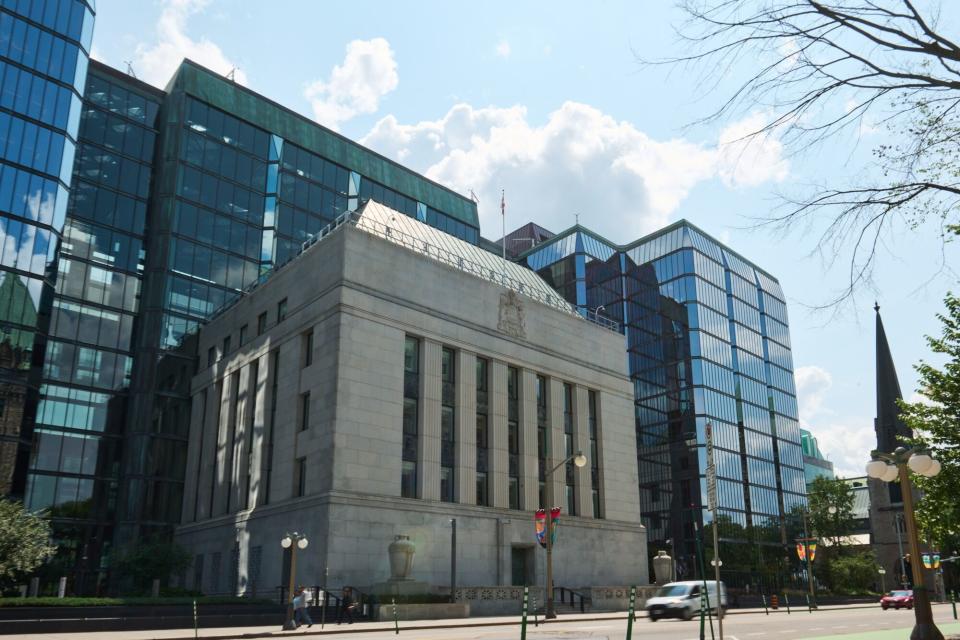Bank of Canada’s Path Looks Clear With Soft Landing in Sight
(Bloomberg) -- Economists see a clear road map for the Bank of Canada now that inflation is close to normal levels — a sequence of quarter-point rate cuts stretching well into next year.
Most Read from Bloomberg
Dense Cities With Low Emissions Suffer Most From Air Pollution, Study Finds
Intergenerational Housing Could Help Older Adults Combat Loneliness
As Rural Hospitals Shutter Maternity Wards, Urban Ones Follow
The central bank is unlikely to opt for outsized cuts as it lowers borrowing costs, according to a new Bloomberg survey. In fact, none of the 18 analysts who responded to the poll believe the bank will reduce the policy rate by 50 basis points or more at any meeting.
Rather, a majority of economists see five cuts of 25 basis points at the next five meetings — including at next Wednesday’s decision — until the benchmark overnight rate is at 3.25%, before a pause in April. Officials led by Governor Tiff Macklem have already cut twice to lower the policy rate from its 5% peak.
The survey suggests forecasters are optimistic about a gradual normalization of monetary policy, consistent with a soft landing for Canada’s economy.
More than two-thirds of economists see yearly inflation returning to the Bank of Canada’s 2% target between the second and fourth quarters of 2025. Just 38% see net job losses in excess of 30,000 in a single month over the next half-year.
They don’t think rates will fall to near pre-pandemic levels. The median forecast is that the Bank of Canada will stop lowering the overnight rate when it reaches 3%. Over half of economists expect officials to start hiking again in the second half of 2026.
To be sure, there are some forecasters who believe the economy is weak enough to warrant larger-than-normal rate cuts. Citigroup economists recently wrote in a note to investors that they expect a 50 basis-point cut in October, but the bank did not participate in this month’s Bloomberg survey.
Nearly three-quarters of respondents say policymakers will continue shrinking the central bank’s balance sheet until the first half of 2025, matching the bank’s own estimates for when it will end quantitative tightening.
Economists are split on what that means for settlement balances, the interest-bearing deposits used as a means of payment in Canada’s high-value payment system, called Lynx. Seven respondents said the bank’s C$20 billion to C$60 billion estimate for the steady state level of balances for the payment system is too low, while six said it’s about right. One said the range was too high.
There’s also no consensus on why the Canadian Overnight Repo Rate Average, known as Corra, has detached from the Bank of Canada’s target in recent months. Half of analysts surveyed agree with the Bank of Canada’s research, which says the move to next-day settlement in Canada’s debt markets is the cause of Corra’s upward drift.
The other half cite other reasons, including the steady decline in settlement balances, regulatory constraints, issuance and the Federal Reserve’s own QT program.
More than 90% of economists surveyed say undershooting the 2% inflation target for a quarter wouldn’t damage the bank’s credibility. Nearly two-thirds say a lack of clarity from Prime Minister Justin Trudeau’s government on a plan to reduce Canada’s non-permanent resident population has some impact on the accuracy of the Bank of Canada’s growth estimates.
The Bloomberg survey of 18 economists was conducted between Aug. 23 and Aug. 28. On Friday morning, Statistics Canada reported gross domestic product rose 2.1% on an annualized basis in the second quarter, beating forecasters’ median estimate of 1.8%.
--With assistance from Jay Zhao-Murray.
Most Read from Bloomberg Businessweek
Need 100,000 Balloons for a Convention? Here’s the Guy to Call
Hong Kong’s Old Airport Becomes Symbol of City’s Property Pain
How TikTok Turned Starface’s Pimple Patches Into a Beauty Obsession
©2024 Bloomberg L.P.


